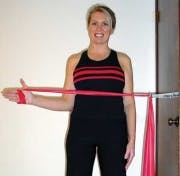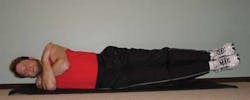Exercise needs of hygienists
How to select exercises that benefit your health – not worsen it
by Bethany Valachi, PT, MS, CEAS
This is just one of numerous stories I hear from dental team members. Most health-care professionals (personal trainers, MDs, massage therapists, etc.) don't realize that due to their unique positioning challenges, dental professionals are predisposed to certain muscle imbalances that can be worsened by specific exercises. When team members come to understand these muscle imbalances, the proverbial lightbulb comes on: "Ah, that's why I always had pain after that exercise."
Preventing work-related pain or disability among dental professionals is rightfully a growing concern, as up to 81% of hygienists experience work-related pain in a 12-month period. A natural tendency is to wait for the painful episode before taking action. Unfortunately, by this time, irreversible structural damage may have occurred. Hygienists must, therefore, become advocates for their own musculoskeletal health and implement wise prevention strategies prior to the painful episode. Developing balanced musculoskeletal health through proper strengthening exercises can help dental hygienists avoid work-related pain, injury, or early retirement.
Hygienists should address three areas before initiating any strengthening exercise program:
- Resolve ergonomic issues in the operatory.
- Treat trigger points.
- Develop good flexibility and range of motion.
"The 6 Keys to Wellness in Dentistry: Essential Steps to Improve Your Musculoskeletal Health" is a downloadable article at www.posturedontics.com that focuses on these steps.
Unbalanced muscles
In order to perform the precision tasks of dentistry, the arms must have a stable base from which to operate. For example, the delivery of dental hygiene requires excellent endurance of the shoulder girdle stabilizing muscles (especially the middle and lower trapezius muscles) for safe shoulder movement and working posture (Fig. 1 – in blue). These shoulder-stabilizing muscles tend to fatigue quickly with forward head, rounded upper back, and elevated arm postures – all commonly seen among hygienists. When these muscles fatigue, other muscles (upper trapezius, levator scapula, and upper rhomboids) must compensate and become overworked, tight, and ischemic (Fig. 1 – in red).
At left, Figs. 1A and 1B: Dental hygienists should avoid excessive strengthening of muscles that tend to become overworked, tight, and ischemic (in red). Muscles that should be targeted for endurance training include the shoulder girdle and trunk-stabilizing muscles (in blue).
This muscle imbalance may result in "tension neck syndrome," the most frequently diagnosed disorder among dental hygienists. Symptoms include pain, tenderness, and stiffness in the neck and shoulder musculature, commonly with pain that radiates between the shoulder blades or up into the occiput. Two contributing factors to tension neck syndrome in dentistry are forward head and elevated arm postures.
Another common imbalance among hygienists is in the shoulder, caused by overstrengthening the deltoid and supraspinatus muscles. These muscles already tend to be strong in hygienists due to frequent postures with the arms lifted away from the sides of the body. This imbalance can cause improper movement at the shoulder joint, with painful impingement of the rotator cuff tendon.
The muscle imbalance that tends to develop between the abdominal and low back muscles is especially problematic in seated dentistry. Leaning toward a patient repeatedly with rounded back posture can cause strain and overexertion in the superficial low back extensors, while the deep stabilizing abdominal muscles (transverse and oblique abdominals) tend to become weaker.
The core of the problem
In a society that bombards us with exercise options, from Ab-blasters to Bun-busters, it's hard to imagine that strengthening your muscles could be anything but beneficial. Yet, because of the muscle imbalances described above, all exercise is not necessarily good exercise for dental hygienists. Due to their vulnerability to muscle imbalances, most hygienists should focus on specific strengthening of the core stabilizing muscles of the shoulder and trunk (Fig. 1 – in blue) and avoid overstrengthening muscles already prone to imbalance, tightness, ischemia, and pain (Fig. 1 – in red).
The core muscles of the trunk and shoulder girdle are designed to provide a firm and safe foundation from which the upper body and arms can move. Core strengthening is the cornerstone of Pilates, a program that offers many benefits for dental hygienists' musculoskeletal health. However, some Pilates moves are not appropriate for dental hygienists and must be modified to keep them from being thrown into the "vicious pain cycle." These same exercise moves generally are not a problem for the average individual who does not work in dentistry. Exercising on a Swiss exercise ball also targets the core muscles by creating an unstable base of support from which to move. Regardless of the avenue you take to get there, you should also be aware of certain exercises that can worsen imbalances and make your muscles miserable.
Exercise wisely
Since the postural stabilizing muscles (Fig. 1 – in blue) perform low-level static contractions for prolonged periods, they must be trained for endurance in a similar manner.
- Use light resistance and high repetitions when training these muscles, usually an elastic exercise band is sufficient for the shoulder muscles, while gravity-resisted exercise on the floor or an exercise ball is good for the trunk muscles.
- Perform strengthening exercises three times a week, always allowing one day in between sessions.
- Begin with the minimum number of repetitions and increase repetitions only when you have performed the exercise for two weeks with NO pain.
- Strengthening exercises should only be performed when there is no musculoskeletal pain and full range of motion is present.
- Consult your doctor when beginning a new exercise, especially if you have a history of injury or illness.
- It is a good idea to seek professional guidance from a physical or occupational therapist to ensure good technique.
Diagonal Pull-Downs
Diagonal Pull-Downs
Secure elastic exercise band in a closed door using a Theraband door anchor. Grasp the band in both hands and position arms at sides with fingers pointing upward. Maintain an ear-over-shoulder posture, exhale, and pull your navel toward spine, holding this contraction throughout the exercise. Roll shoulders back and down, squeezing shoulder blades downward and together. Pause, and slowly return. You should be able to perform 15 repetitions easily. If you have discomfort, decrease the resistance of the elastic exercise band.
External Rotation
Wrap elastic band loosely around one hand. Keeping elbow tightly pressed against your side, rotate arm outward. Slowly return to beginning position. You should be able toExternal Rotation
Side Lift
Lie on your side with arms crossed. Exhale, and slowly lift both legs four to five inches off the floor. Hold for three to five seconds and repeat 10 times. Repeat for the other side.
Supine Leg Lifts
Lie on your back, with knees bent, holding the ball in the air above you. Exhale, and pull your navel toward your spine, holding this contraction throughout the exercise. Slowly extend one leg, hold for three to five seconds, then return to the start position. Repeat with the other leg. To make the exercise more difficult, hold the legs closer to the floor. Caution: Do not let your low back arch off the floor during this exercise – this may cause a low back strain or injury.
Side Lift
Pointer Dog
Position yourself on hands and knees. Exhale as you pull your navel up toward your spine. Hold thisSupine Leg Lifts
The previous exercises are from the "Smart Moves for Dental Professionals On the Ball" Home Exercise DVD. All 20 exercises, as well as exercises that should be avoided by dental hygienists, are in the DVD kit available at www.posturedontics.com.
Conclusion
Embarking on an exercise program requires prudence and discretion, considering team members' predisposition to certain muscle imbalances. Selecting improper exercises can lead to imbalance, ischemia, nerve impingement, and other pain syndromes. Developing balanced musculoskeletal health with a well-designed exercise program can help hygienists prevent work-related pain, avoid injuries, extend their careers, and improve their quality of life.
Pointer Dog
Bethany Valachi, PT, MS, CEAS, is a physical therapist, dental ergonomic consultant, and CEO of Posturedontics®, a company that provides research-based education. Clinical instructor of ergonomics at OHSU School of Dentistry, Valachi lectures internationally at dental meetings, schools, and study clubs. She covers the above topics and more in her book, "Practice Dentistry Pain-Free: Evidence-based Strategies to Prevent Pain and Extend Your Career," available at www.posturedontics.com. For a free copy of exercises that worsen dental professionals' health, please contact [email protected] or call (503) 291-5121.
Past RDH Issues






